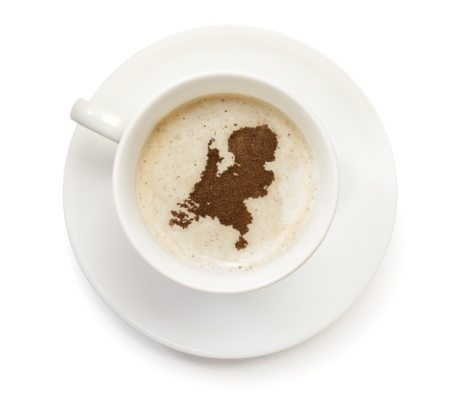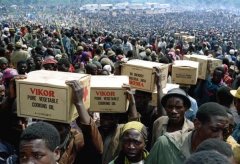Introduction to the producing area of Coffee-Ethiopia in Africa

For professional baristas, please follow the coffee workshop (Wechat official account cafe_style)
Ethiopia is the birthplace of coffee, which can start directly from the history of drinking.
In 850, a shepherd in Ethiopia found that his goat became energetic after eating a certain fruit.
When a group of hating couples learned that they ate it but felt very bitter and disappointed, they threw the picked fruit into the fire. The fragrance gradually sprang up from the fire.
The lovers were curious and pondered the roasted and fragrant fruit in the fire.
The lovers grind the fruit into powder and make it into a drink. Unexpectedly, he was very excited all night after drinking it, so the hated couples thought that the fruit was a gift from God.
Coffee was first imported to Arabia from Ethiopia in the 11th century, and Persians were enthusiastic about the excitement of this "Islamic wine" made from coffee.
In the 15th century, coffee spread to the Arab Empire and Cairo through the cities of Mecca and Medina.
In the 16th century, it became popular in Arabia, Asia minor, Syria, Egypt, Southeast Europe and other places. The first coffee shop opened in Damascus, Syria, in 1530.
In 1615, coffee was spread throughout Europe. A Venice businessman brought coffee beans to Western Europe, and the aroma of coffee quickly became the most popular drink.
The European market is expanding rapidly. In order to increase supply, the European crew exported it to the colonies to breed. This is an era of great geographical discovery, through which coffee production began to spread around the world.
In 1683, the Ottoman Empire lost the Battle of Vienna and left 500 bags of coffee in Vienna. A Polish businessman used the coffee to open his first coffee shop in Vienna.
With the development of coffee cultivation, Ethiopia has become an important coffee producer.
Under the world's well-known boutique coffee, Ethiopia plays a more important role in returning to basics and whirling taste.
There are only ancient excellent native varieties of coffee in Ethiopia.
Ethiopia, as the birthplace of coffee, has mated and propagated different varieties of coffee for thousands of years, which has led to thousands of varieties in Ethiopia today.
The original species is not that technology can know for sure that a certain variety is the ancestor of all the coffee on the market, but that there are too many varieties to be distinguished at all, so let's call it the original species.
In addition to the native species, you can also hear the "Yega Sheffield species" and "Sidamo species". This kind of variety named after the producing area does not make much sense, because even if the variety is distinguished by origin, it still can not reach the true meaning of distinguishing a single variety.
Harari Harari
Yega Xuefei Yirgacheffe
Sidamo Sidamo
This is common in Taiwan and is located in the east of the East African Rift Valley in Ethiopia. Other producing areas in the west are only common in Japan or Europe and the United States.
If you want to drink a cup of these unusual coffee in Taiwan, it is easier to drink it only in stores that sell raw beans directly with foreign businessmen.
As for the name Harari, you may have seen the name "Harari Moka". After confirming that Harari is the name of the producing area, what does Mocha mean?
It refers to the Yemeni port of Moka on the Arabian Peninsula.
The two names of "Harari" and "Mocha" were put together because in the early days, Harari had to rely on shipping at the Yemeni port of Moka in order to export Harari coffee to all parts of the world.
Perhaps at that time, we did not attach importance to the origin, only paying attention to the fact that the coffee was transported from the port of Mocha, no matter where it was planted, it was all named after the port of Mocha.
Coffee is also grown locally in Yemen. In order to distinguish between coffee produced in Harari and Yemeni coffee, two kinds of coffee also exported from the port of Mocha are divided into "Harari mocha" and "Yemeni mocha".
As the quality of Ethiopian coffee is very distinct in the world, if the management can not keep up with the nature of the product, it is easy to give rise to fake goods and price problems.
Nowadays, Harari mochas are becoming more and more rare in Taiwan, otherwise they are expensive.
More than 60% of Ethiopians produce coffee through natural cultivation, rather than the usual business operations in Central and South America. Therefore, coffee is usually named after cooperatives, processing plants, small farmers or towns.
What is the impact of this named coffee?
First of all, you need to understand the difference between a coffee named "manor" and a "processing plant".
A manor is an estate where coffee is grown. The information on the conditions of replanting can be obtained through the manor.
However, coffee cannot be roasted in Taiwan as soon as it is picked. It has a peel and pulp on it, and the fruit itself is still wet.
In order to make coffee a trade-friendly raw bean, it is necessary to implement this step through the processing unit, and different treatments also create a different appearance of coffee.
It is the job of the "processing plant" to process the raw beans as we see them. Sun exposure, water washing, honey treatment, etc., are all things to be done by the processing plant.
The following are examples of various explanations under different names
Vivetta Nango Ingert Manor
It is impossible to find beans named other processing plants because there is its own processing plant inside Ingert Manor.
Honduras Holy Rose processing Plant
It is more difficult for this bean to have standard natural conditions because the beans are collected by small coffee farmers near the processing plant. But the treatment is sure to be consistent.
Nicaraguan Santo Domingo Cooperative
The name of the cooperative is the joint processing unit. It may be a unit set up by a social welfare and external subsidy, rather than a unit that may be privately owned by a manor or a processing plant.
Apart from the difference in the name of establishment, in fact, the functions of co-operatives are quite different from those of processing plants.
South Minas Otavino small farmers peel and bask in the sun
The name is small farmers, which literally means coffee produced by coffee farmers in a certain town or zone.
However, if coffee production is collected from small farmers, there are already single processing units such as processing plants and cooperatives that belong to the same kind of coffee production units.
Therefore, small farmers' coffee may have more than two processing plants, or small farmers may have their own methods of handling coffee, and they will only be called small farmers if they come to collect and buy coffee, trade directly with businessmen, and so on.
Alim small Farmers of the Yega Sheffiwoca Cooperative
The Waka Cooperative is used as a processing unit, while Alim small farmers are small farmers in a zone. In series, the coffee produced by small farmers in the Alim belt is sold by the Waka Cooperative.
This situation is easy to happen in areas where water resources are poor, and it is not easy to build a well, so precious well drilling can only be carried out at the center of multiple life circles.
When facilities such as wells are completed, coffee processing facilities will be built here for use by small farmers in different living circles around them. This situation is in line with the concept of co-operatives, but it will also give rise to situations in which there are different small farmers.
Tarazhubaihua Manor Angel treatment Plant Red Honey treatment
There are manors and processing plants, which means that coffee is grown from baihua Manor and then sent to the processing plant for processing. The information will be very complete.
Usually in this case, the boss is the same person. However, the manor and the processing plant have their own business to undertake other business, so it is called independently in the name.
If you want to understand the naming logic of coffee
I think you have to be confident in your logic first.
Let's introduce the common Yega Xuefei.
Yega Xuefei was a sought-after coffee before it caught the world's attention. At that time, Yejia Xuefei did not have today's complete and diversified production processing units, only full of traders in the rush for goods.
As the trading environment at that time was one-sided bargain by businessmen, no matter how hard Ethiopia tried to increase supply, it was always unable to get a better income.
For self-sufficient Ethiopian people, coffee is a farm for social communication and a small amount of currency.
It was only when the government curtailed the domestic sale of coffee to benefit foreign exchange in 2000 that the domestic people began to feel the coffee trade environment.
When supply falls short of demand, coupled with the continued downward pressure on prices, businessmen realize that the cost-down strategy has reached its limit.
In addition, with the gradual rise of boutique coffee focusing on the origin, businessmen have changed their strategies one by one, from price-cost strategy to assistance-oriented coffee production, and through aid production, they have gained a direct relationship that is difficult for others to snap up.
Yejia Xuefei is not only an indispensable item in coffee, but also has an irreplaceable brand. In order to own this kind of patent, Starbucks even registered "Yejasuefi" as a trademark directly in 2004.
It was not until 2007, when the government filed an international lawsuit, that the name of Yejassefi Coffee was liberated.
Yejia Xuefei originally belonged to the next producing area of Sidamo, but its citrus, jasmine and other styles were so prominent that it gradually became independent in the distribution of producing areas.
The Sidamo producing area and Yega Xuefei support each other. Although Yega Xuefei has a very outstanding quality, in practical terms, Sidamo often replaces Yega Xuefei in matching beans.
Important Notice :
前街咖啡 FrontStreet Coffee has moved to new addredd:
FrontStreet Coffee Address: 315,Donghua East Road,GuangZhou
Tel:020 38364473
- Prev

Introduction of Coffee Origin-Asian "Sri Lanka, Bali, Yunnan, China"
For professional baristas, please follow the coffee workshop (Wechat official account cafe_style) Sri Lanka, formerly known as Ceylon. Sri Lankan black tea and Ceylon black tea refer to the same thing. In 1658, the Dutch grew coffee in Ceylon (present-day Sri Lanka), but the coffee was sufficient for economic development until the 19th century. At this time, Britain occupied Ceylon and launched a variety of cash crops.
- Next

Introduction to the origin of coffee-"Rwanda, Burundi" of the African Department
For the exchange of professional baristas, please follow the coffee workshop (Wechat official account cafe_style) today to introduce the five East African countries, and then introduce the coffee from the five East African countries individually. In 2015, five East African Communities, including Kenya, Tanzania, Burundi, Rwanda and Uganda, proposed that five countries be merged into a federal state, using a common constitution, president, parliament and goods.
Related
- Detailed explanation of Jadeite planting Land in Panamanian Jadeite Manor introduction to the grading system of Jadeite competitive bidding, Red bid, Green bid and Rose Summer
- Story of Coffee planting in Brenka region of Costa Rica Stonehenge Manor anaerobic heavy honey treatment of flavor mouth
- What's on the barrel of Blue Mountain Coffee beans?
- Can American coffee also pull flowers? How to use hot American style to pull out a good-looking pattern?
- Can you make a cold extract with coffee beans? What is the right proportion for cold-extracted coffee formula?
- Indonesian PWN Gold Mandrine Coffee Origin Features Flavor How to Chong? Mandolin coffee is American.
- A brief introduction to the flavor characteristics of Brazilian yellow bourbon coffee beans
- What is the effect of different water quality on the flavor of cold-extracted coffee? What kind of water is best for brewing coffee?
- Why do you think of Rose Summer whenever you mention Panamanian coffee?
- Introduction to the characteristics of authentic blue mountain coffee bean producing areas? What is the CIB Coffee Authority in Jamaica?

